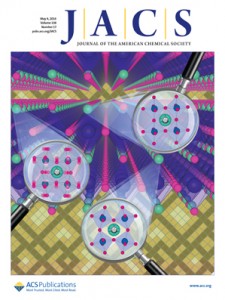M. S. Senn, C. A. Murray, X. Luo, L. Wang, F.-T. Huang, S.-W. Cheng, A. Bombardi, C. Ablitt, A. A. Mostofi and N. C. Bristowe, Symmetry switching of negative thermal expansion by chemical control,
J. Am. Chem. Soc. 138, 5479 (2016)
Most materials expand when they are heated, but a few do the opposite as a result of certain kinds of atomic vibrations. Ideally, we would like to be able to precisely dial-in a material’s thermal response, but in these complex systems fine control has been elusive.
In this work, which appears on the cover of JACS, the layered perovskite Ca3–xSrxMn2O7 is shown to exhibit a switching from a material exhibiting uniaxial negative to positive thermal expansion as a function of x. The switching is shown to be related to two closely competing phases with different symmetries. The negative thermal expansion (NTE) effect is maximized when the solid solution is tuned closest to this region of phase space but is switched off suddenly on passing though the transition. Our results show for the first time that, by understanding the symmetry of the competing phases alone, one may achieve unprecedented chemical control of this unusual property.
This work was done in collaboration with Mark Senn at the University of Oxford and others and forms part of Chris Ablitt‘s PhD in the Centre for Doctoral Training in Theory and Simulation of Materials. Chris is supervised by Nicholas Bristowe, Mark Senn and Arash Mostofi.
